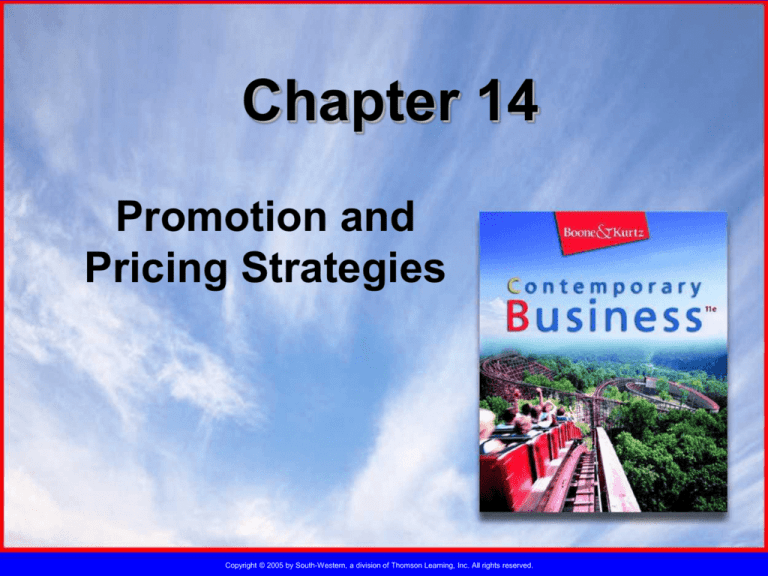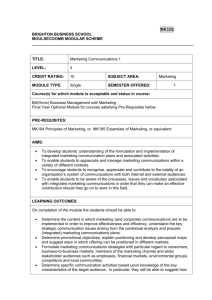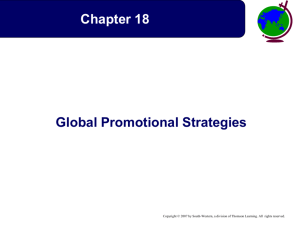
Chapter 14
Promotion and
Pricing Strategies
Copyright © 2005 by South-Western, a division of Thomson Learning, Inc. All rights reserved.
Promotion – communication to inform,
persuade, and influence a purchase decision.
Integrated Marketing Communications
Coordination of all promotional activities
(advertising, personal selling, sales
promotion, and public relations) to produce a
unified customer-focused message.
14-2
Copyright © 2005 by South-Western, a division of Thomson Learning, Inc. All rights reserved.
The Promotional Mix
Promotional Mix—combination of personal
and nonpersonal selling techniques designed to
achieve promotional objectives.
Personal Selling—interpersonal promotional
process involving a seller’s face-to-face
presentation to a prospective buyer.
Nonpersonal selling—consists of advertising,
sales promotion, direct marketing, and public
relations
14-3
Copyright © 2005 by South-Western, a division of Thomson Learning, Inc. All rights reserved.
Comparing the Components of the
Promotional Mix
14-4
Copyright © 2005 by South-Western, a division of Thomson Learning, Inc. All rights reserved.
Five Major Promotional Objectives
14-5
Copyright © 2005 by South-Western, a division of Thomson Learning, Inc. All rights reserved.
Providing Information
Major portion of U.S. advertising is informationoriented
Differentiating a Product
Positioning: communicate meaningful
distinctions about the attributes, price, quality,
or use of a good or service
Increasing Sales
Most common objective
Stabilizing Sales
Stimulate sales during slack periods
Accentuating the Product’s Value
explain often unrecognized ownership benefits
14-6
Copyright © 2005 by South-Western, a division of Thomson Learning, Inc. All rights reserved.
Advertising
Advertising—paid nonpersonal
communication delivered through various
media and designed to inform, persuade, or
remind members of a particular audience.
14-7
Copyright © 2005 by South-Western, a division of Thomson Learning, Inc. All rights reserved.
Advertising
Types of Advertising
Product Advertising—consists of
messages designed to sell a particular
good or service
Institutional Advertising—involves
messages that promote concepts, ideas,
philosophies, or goodwill for industries,
companies, organizations, or government
entities
14-8
Copyright © 2005 by South-Western, a division of Thomson Learning, Inc. All rights reserved.
Advertising
Advertising and the Product Cycle
Informative Advertising - seeks to build initial
demand for a product -Introductory stage
Persuasive Advertising - seeks to improve the
competitive status of a product, institution, or
concept, Growth and Maturity stages
Comparative Advertising - compares
products directly with their competitors
Reminder-oriented advertising - maintain
awareness, importance, and usefulness of a
product, concept, or institution Late maturity or
Decline stages
14-9
Copyright © 2005 by South-Western, a division of Thomson Learning, Inc. All rights reserved.
Advertising
Advertising Media
Must choose how to allocate advertising
budget
All media offer advantages and
disadvantages
Must consider cost and which media is
best suited for communication
14-10
Copyright © 2005 by South-Western, a division of Thomson Learning, Inc. All rights reserved.
Advertising Media
Newspaper
Dominate local advertising
Disadvantage: relatively short life span
Television
America’s leading national advertising
medium
An expensive advertising medium
14-11
Copyright © 2005 by South-Western, a division of Thomson Learning, Inc. All rights reserved.
Advertising Media
Radio
Captive audience of listeners as they
commute to and from work
In major markets, many stations serve
different demographic groups with targeted
programming
Magazines
Includes consumer publications and trade
journals
Can often customize their publications and
target advertising messages to different
regions of the country
14-12
Copyright © 2005 by South-Western, a division of Thomson Learning, Inc. All rights reserved.
Advertising Media
Direct Mail
Address lists are the heart of this media
Benefit – can carefully target the mailing
Catalogs, “junk mail”, email
Online and Interactive Advertising
Web sites, banner ads, pop-up ads
Fastest-growing media segment
Outdoor Advertising
Very small part, but growing
Billboards, buses, signs in transit stations,
stores, airports, and stadiums
Disadvantages: Brief messages required
14-13
Copyright © 2005 by South-Western, a division of Thomson Learning, Inc. All rights reserved.
Advertising Media
Sponsorship—involves providing funds
for a sporting or cultural event in exchange
for a direct association with the event
Sports sponsorships attract two-thirds of
total sponsorship dollars
Primary benefits: exposure to the event’s
audience and association with the image of
the activity
14-14
Copyright © 2005 by South-Western, a division of Thomson Learning, Inc. All rights reserved.
Advertising Media
Sponsorship—involves providing funds for a
sporting or cultural event in exchange for a direct
association with the event
Other Media Options
Infomercials
Ads in movie theaters
Ads on airline movie screens
Printed programs, Subway tickets
Turnpike toll receipts
Automated teller machines
14-15
Copyright © 2005 by South-Western, a division of Thomson Learning, Inc. All rights reserved.
Sales Promotion
Sales promotion—nonpersonal marketing
activities other than advertising, personal
selling and public relations that stimulate
consumer purchasing and dealer
effectiveness.
Potential advantages:
Short-term increased sales
Increased brand equity
Enhanced customer relationships
14-16
Copyright © 2005 by South-Western, a division of Thomson Learning, Inc. All rights reserved.
Sales Promotion
Consumer-Oriented Promotions
Goals of a consumer-oriented sales
promotion include:
Getting new and existing customers to
try or buy products
Encouraging repeat purchases by
rewarding current users
Increasing sales of complementary
products
Boosting impulse purchases
14-17
Copyright © 2005 by South-Western, a division of Thomson Learning, Inc. All rights reserved.
Spending on Consumer-Oriented Promotions
14-18
Copyright © 2005 by South-Western, a division of Thomson Learning, Inc. All rights reserved.
Sales Promotion
Consumer-Oriented Promotions
Premiums - items given free with purchase.
Coupons - offer small price discounts
Rebates - offer cash back to consumers
Sample - a gift of a product
Games, Contests, and Sweepstakes - offering
cash, merchandise, etc. as prizes
Promotional Products - gift of useful
merchandise that carries the name, logo, or
slogan of organization. Ex: RVCC pen
14-19
Copyright © 2005 by South-Western, a division of Thomson Learning, Inc. All rights reserved.
Sales Promotion
Trade-Oriented Promotions
Trade promotion—sales promotion
geared to marketing intermediaries
Used to encourage retailers to:
Stock new products
Continue carrying existing ones
Promote products effectively to
consumers.
14-20
Copyright © 2005 by South-Western, a division of Thomson Learning, Inc. All rights reserved.
Sales Promotion
Trade-Oriented Promotions
Point-of-purchase (POP) advertising—
displays or demonstrations that promote
products when and where consumers buy
them
Takes advantage of many shoppers’
tendencies to make purchase decisions
in the store
Trade shows—promote goods or services
to intermediaries
14-21
Copyright © 2005 by South-Western, a division of Thomson Learning, Inc. All rights reserved.
Personal Selling
Personal selling—direct person-to-person
promotional presentation to a potential buyer.
Including face-to-face, via telephone,
videoconference, or interactive link. (Expensive)
Used most often when:
Customers are relatively few in number and
geographically concentrated
Product is technically complex, involves tradeins, and requires special handling
Product is high in price
Product moves through direct-distribution
channels
14-22
Copyright © 2005 by South-Western, a division of Thomson Learning, Inc. All rights reserved.
Personal Selling
The Sales Process
Seven Steps in
the Sales
Process
14-23
Copyright © 2005 by South-Western, a division of Thomson Learning, Inc. All rights reserved.
Public Relations
Public Relations—organization’s
communication and relationships with its
various audiences.
Publicity—stimulation of demand for a good,
service, place, idea, person, or organization
by disseminating news or obtaining favorable
unpaid media presentations.
14-24
Copyright © 2005 by South-Western, a division of Thomson Learning, Inc. All rights reserved.
Promotional Strategies
Selecting a Promotional Mix
Guidelines for allocating promotional
efforts and expenditures among personal
selling and advertising:
What is your target market?
What is the value of the product?
What time frame is involved?
14-25
Copyright © 2005 by South-Western, a division of Thomson Learning, Inc. All rights reserved.
Pushing and Pulling Strategies
Pushing strategy—Promote to members
of the distribution channel, not to end
users. Thereby pushing it through the
channel
Cooperative advertising—allowances
in which firms share the cost of local
advertising of their product or line with
channel partners
Pulling strategy— Generate consumer
demand by promoting to final users who
will then exert pressure on the distribution
channel to carry the good or service,
pulling it through the distribution channel
14-26
Copyright © 2005 by South-Western, a division of Thomson Learning, Inc. All rights reserved.
Ethics in Promotion
Puffery and Deception
Puffery - exaggerated claims of a product’s
superiority or use of doubtful, subjective, or
vague statements
Promotion to Children and Teens
Children not sophisticated at analyzing
promotional messages
Promotion in Public Schools and on College
Campuses
Some schools sign contracts that give certain
brands exclusive access to their students
14-27
Copyright © 2005 by South-Western, a division of Thomson Learning, Inc. All rights reserved.
Price in the Marketing Mix
Price—
exchange
value of a good
or service.
Pricing
Objectives
14-28
Copyright © 2005 by South-Western, a division of Thomson Learning, Inc. All rights reserved.
Price in the Marketing Mix
Profitability Objectives
Perhaps the most commonly used
objective in firms’ pricing strategies
Some firms try to maximize profits by
reducing costs rather than through price
changes
Volume Objectives
Bases pricing decisions on market share
Market share: the percentage of a market
controlled by a certain company or product
14-29
Copyright © 2005 by South-Western, a division of Thomson Learning, Inc. All rights reserved.
Price in the Marketing Mix
Price to Meet Competition
Seeks to meet competitors’ prices
Prestige Objectives
Prestige pricing encompasses the effect of
price on prestige
Prestige pricing establishes a relatively
high price to develop and maintain an
image of quality and exclusiveness
14-30
Copyright © 2005 by South-Western, a division of Thomson Learning, Inc. All rights reserved.
Pricing Strategies
Price Determination in Practice
Cost-based pricing—practice of adding a
percentage of specific amounts (mark-up)
to the base cost of a product to cover
overhead costs and generate profits.
14-31
Copyright © 2005 by South-Western, a division of Thomson Learning, Inc. All rights reserved.
Breakeven Analysis—pricing technique used to
determine the minimum sales volume a product must
generate at a certain price level to cover all costs.
14-32
Copyright © 2005 by South-Western, a division of Thomson Learning, Inc. All rights reserved.
Alternative Pricing Strategies
Skimming pricing strategy - set an
intentionally high price
Penetration pricing strategy - set a low price
as a major marketing weapon
Everyday Low Pricing and Discount Pricing Strategy devoted to maintaining continuous low
prices rather than relying on short-term pricecutting tactics
Competitive Pricing - product priced at the
general level of competing offerings
Odd Pricing - Odd pricing (charging $39.95 or
$19.98 instead of $40 or 20)
14-33
Copyright © 2005 by South-Western, a division of Thomson Learning, Inc. All rights reserved.







